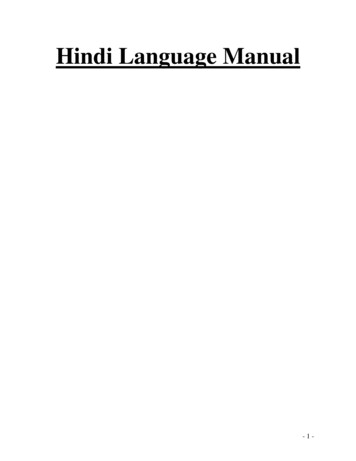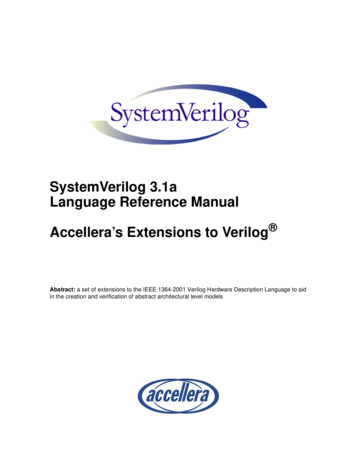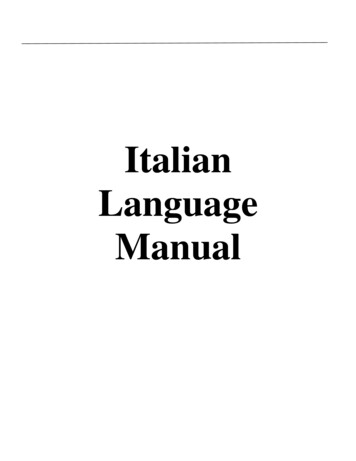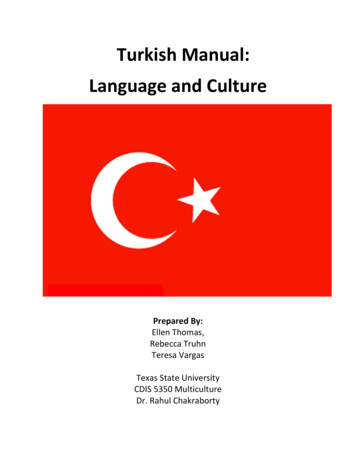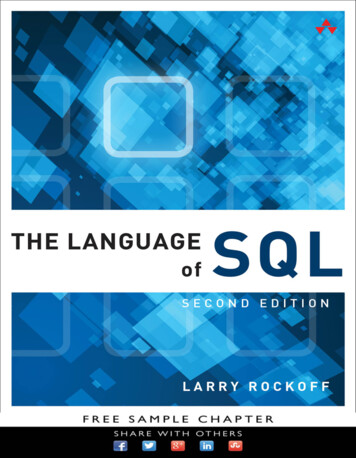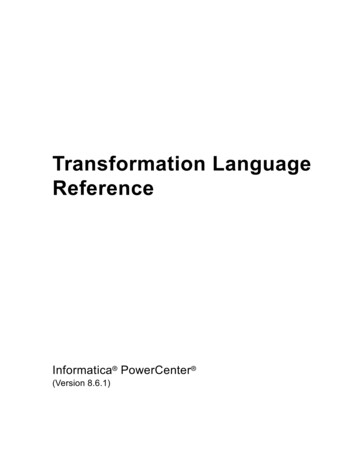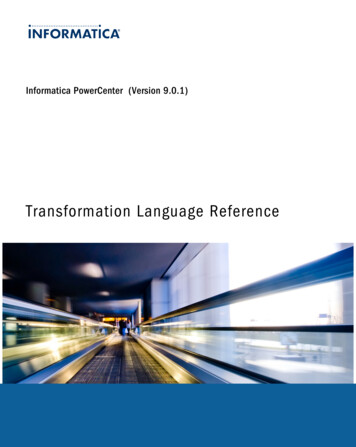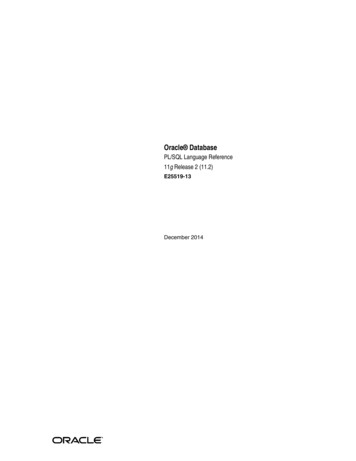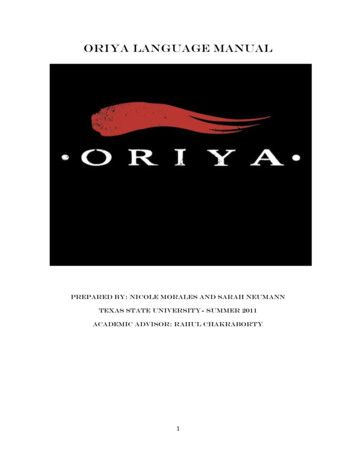
Transcription
Oriya Language ManualPrepared by: Nicole Morales and Sarah NeumannTexas State University- Summer 2011Academic Advisor: Rahul Chakraborty1
Table of ContentsLinguistic Community .3Demography 3-5Geographical Distribution of the Language 4Population in the USA 5Linguistic Features 6-11Phonology .6-7Morphology .7Syntax .8Semantics .8Pragmatics .8-11Speech Samples 11Linguistic Transfer .11Assessments & SLP’s with a Target Language Background 11-13Social Aspects & Culture . 13-17Resources 182
Linguistic CommunityOriya is an Eastern Indo-Aryan language that is primarily spoken in theIndian state of Orissa. It is recognized as one of the official languages ofIndia and over 33 million people speak Oriya. It is derived from Sanskritand other languages similar to Oriya include Bangla, Assamese, Maithili,Magahi, and Bhojpuri. Indian states such as Jharkhand, West Bengal,Andhra Pradesh, and Gujarat also include a significant amount of Oriyaspeakers. Specifically in the city of Surat, Gujarat there is a significantOriya community due to immigration works in the diamond polishing andtextile industries. Although Oriya is the mother language of Oriya, Telugu,Bengali, and Hindi are also spoken in this state.Oriya has several dialects, which include:Mughalbandi: Considered the standard, most formalSambalpuri: Spoken in the districts of Sambalpur,Sundergarh, Kalahandi, Bolangir, and BaudaBhatri: a transitional dialectDemographyAccording to the 2001 census, there are significantly more speakers in ruralareas than in urban areas in Orissa. The following includes information onthe amount of Oriya speakers in sgarhJharkhandAndhra PradeshAssamWest BengalGujaratMaharashtraDelhiTripuraMadhya PradeshPersons thatspeak toryIndiaOrissaChhattisgarhJharkhandAndhra PradeshAssamWest BengalGujaratMaharashtraDelhiTripuraMadhya Pradesh3Male male ,708112,91674,26724,34329,96010,82911,3908,590
Orissa is bound to the North by Jharkhand, to the Northeast byWest Bengal, to the East by the Bay of Bengal, to the South byAndhra Pradesh, and to the West by Chhattisgarh.The capital of Orissa is Bhubaneswar. It is commonly referred toas the Temple city, and contains relics to the rich religious historyand traditional heritage of the state. It is also an importantcultural and industrial center of orissa.htmlhttp://www.lisindia.net/oriya/Oriya a/orissa-4
The geographical distribution of Oriya speakers throughout India,according to the 2001 census.Population in the USAAlthough the exact number of Oriya speakers in the U.S. is not reported,there are several states that have Orissa organizations. According towordlorissa.com, Orissa societies are located in Maryland, New York,Illinois, Virginia, Michigan, and New Jersey. These societies help supportthe culture and language of Orissa throughout the United States and arealso spreading around the world to other countries such as Singapore,Canada, and sa/exploreworldorissa.htm5
Linguistic FeaturesPhonologyThe retroflex sounds are represented by letters with dots beneath themand they differ from their dental counterparts in the position of the tonguetip during articulation. For dentals, the tongue tip is touching the upperteeth, but for the retroflexes, the tongue is curled back along the roof of themouth. The closest English equivalent to the retroflex sounds occurs whenan alveolar consonant precedes/r/ (e.g., “dream”).All consonants, except /n/, /n/, and /l/ may occur word initially. J([y]) is often pronounced ĵ. The distinction among the three fricatives s, š,and s (with dot beneath it) is preserved only in literary pronunciation; incolloquial speech, all three are pronounced [s].The following chart presents the differences between oral and nasal vowelsis phonemic in Oriya:http://accent.gmu.edu/browse native.php?function detail&languageid 1946
FrontBackHighiuMideoDLowaMorphologyOriya has a rich case system, marking nominals for accusative/dative(-ku), instrumental (-re), ablative (-ru), genitive (-r D), and locative (-re/-ri)cases. Nouns in the nominative are not marked. Case markers may bepreceded by plural markers, or by the definite marker. The accusative caseis used only when the direct object is specific. Oriya nouns can be singularor plural: pila „child‟ pila-maane „children‟.Oriya also has a rich distribution of pronouns-first-, second-, andthird-person pronouns; the remote demonstrative; the proximatedemonstrative pronouns; the correlative and the relative pronouns; thereflexive pronoun; and the honorific and the interrogative pronouns.Oriya verbs are inflected for tense and agree with their subjects inperson and number, but not in gender, as illustrated in the conjugation ofthe of the verb jaa- „go‟ in the present continuous tense, formed bycombining the participle with inflected forms of the auxiliary - Dčh „to be‟.The past continuous is based on the auxiliary thiba „to stay‟. Other tenses(past, present, and future) are formed without auxiliaries.7
SyntaxThe unmarked word order in Oriya is Subject-Object-Verb. Becauseverbs agree with their subjects in person and numbers, sentences canappear without the subject.In standard Oriya the negative particle nãhi is suffixed to the verb (asillustrated above), but in the Sambalpuri dialect, as in Hindi, the negativeparticle is prefixed to the verb. The nonfinite past participle is formed byadding the suffix –i to the verb stem. A series of past participles, onefollowed by another also occurs in Oriya, as seen below. Such formationsare referred to as serial verb constructions.Causative verbs in Oriya are formed by adding –a to verb roots: pi-a„cause to drink‟, ji-a „cause to live‟, khu-a „cause to eat‟.Garry, Jane, & Rubino, Carl. (Ed.). (2001). Facts about the world's languages: anencyclopedia of the world's major languages, past and present. New York & Dublin: A NewEngland Publishing Associates Book.SemanticsMost vowels can be short or long, the length of the vowel changesthe word meaning completelyStress in Oriya generally falls on the next-to-last syllable of a word.Standard Oriya has a lexicon that is composed of loanwords fromHindi, Gujarati, Nepali, Sanskrit, and even Portuguese.PragmaticsEye Contacto If doing business, it‟s not uncommon to keep eye contact, but itmay seem odd to hold it intently for a while. You should lookaway or down every once in a while, using it as a chance togather your thoughts.8
o When speaking to elders it is common to use indirect eyecontact.o Direct eye contact is becoming a little more acceptable, but insome parts of the country it can be inappropriate and rude tohave direct eye contact. Especially for women to make directeye contact with their husbands.Greetingso Most all meetings generally begin with palms pressed togetheraround chest level and saying “Namaste” or “Namaskar”(more formal). People usually nod or bow slightly.o Man greeting man- light handshakes are common after theinitial “Namaste”. Sometimes Namaste alone will suffice.o Woman greeting woman- light handshakes are common afterthe initial “Namaste”. Sometimes Namaste alone will suffice.o Greetings between Men & Women- in formal and businesssituations it is usually best to let the woman initiate contact, ifat all. Many Indian women will avoid contact with men inpublic situations. The “Namaste is the most common form ofgreeting.o When greeting an elder, there is a touching of the feet of theelder, with the right hand, then touching your chest. Afterthis, palms are pressed together. Foreigners are not expectedto do this, but should when meeting those of extremely highstatus, like a religious leader or guru.o Hugs and kisses as a form of greeting should be avoided.Personal Space and Touchingo The comfortable amount of personal space duringconversations in India varies with different sub-cultures. Ingeneral Hindus tend to stand about 3 or 3 ½ feet apart.o Indians are not too conscious of their personal space on trains& buses where everyone is usually squashed together.9
o Indians do not generally touch as part of communication,although it is common to see male friends holding hands orwith their arms around each other when they walk. This isusually a sign of friendship.o Men and women hardly ever display any form of physicalaffection in public. Touching of any kind between men andwomen especially when not related can be interpreted asflirting.o Cupping the face of someone in your hands to show affectionis common in families, especially between mothers andchildren.Views of Timeo There is a well-accepted joke among Indians about IST (IndianStandard Time). This basically means that if you have anappointment at noon, you can expect to have your party arriveor for the meeting to begin anywhere from 30 minutes to a daylater. It's best to expect at least an hour delay (although youshould be punctual within about 15 minutes).o Time is viewed as eternal. Indians usually have a "chalta hain"or a relaxed attitude. It is not usually considered rude to belate in social situations.o Trains and buses don't really run on time. People give theirtime freely for the most part.Communication Styleo When communicating it's often the case that Indians will tellyou what you want to hear in order to be polite. It's best to bepatient and see what actions follow the communication.o Indians tend to favor an indirect style of communication overdirect.o One thing to be aware of is the "Head Bobble". In order to bepolite and prevent from losing face, most Indians will nevertell you "No". If they say "Yes" to one of your questions whilebobbling their head (a mixture between a shake and a nod),that "Yes" generally means "No".10
Tabooso Lewd behavior and even simple PDA (public displays ofaffection) are highly frowned upon.o Avoid touching people or moving/passing objects with yourshoes.o Winking and whistling should be avoided.o Grasping the ears signifies sincerity or repentance, since earsare considered sacred, pulling or boxing ones ears is a graveinsult.http://www.culturecrossing.net/basics business student details.php?Id 10&CID a/Oriya.htmlSpeech Samples: http://www.omniglot.com/writing/oriya.htm http://accent.gmu.edu/searchsaa.php?function detail&speakerid 475 http://accent.gmu.edu/searchsaa.php?function detail&speakerid 1084Linguistic TransferFour classes of stops: voiceless aspirated (ph), voiceless unaspirated (p),voiced unaspirated (b), and voiced aspirated (bh). The alveo-palatal nasal ŋis similar to the “ny” sequence in English words like “canyon.Assessments and Speech-Language Pathologists:According to everyculture.com, Orissa is one of the poorest states in India.With limited funds and resources, citizens of Orissa do not receiveadequate health care. This also includes necessary speech and languageservices to improve communication limitations these individuals mayhave. The diversity and variations of Oriya and the strong influences otherlanguages have on it also makes it difficult to find assessments for this11
population. Research is sparse, making it difficult to determine speech andlanguage diagnostic criteria for Oriya speakers.Further investigation of speech and language disorders is needed to helpdevelop appropriate test protocols for this population. With better testprotocols, people of Orissa with communication disorders will benefit fromtherapy services. Because some Orissa citizens speak other languages suchas Telugu, Bengali, or Hindi and because there is little informationprovided on speech-language pathologists who specialize in Oriya, thefollowing professionals may be helpful to treat people from Oriya:Gujarati:Upadhyay, Shweta Austin, TX512-246-7592Facility Type: Speech/Hearing clinicKavrie, Sunita Houston, TX713.942.8205Facility Type: Speech/Hearing clinicHindi:Upadhyay, Shweta Austin, TX512-246-7592Facility Type: Speech/Hearing clinicSpeech & Hearing Clinic-Texas Tech Univ HSC Lubbock, TXJudith Keller,(806) 743-5678Facility Type: College/UniversityZafar, Kausar Katy, TX281-579-1515Facility Type: SLP or AUD Office12
Kavrie, Sunita Houston, TX713.942.8205Facility Type: Speech and Hearing ClinicKumar, Mithilesh Sugar Land, TX832-758-6272Facility Type: Audiology/hearing clinicTelugu:Austin Speech Labs Austin, TXShilpa Shamapant,512-294-6300Facility Type: Speech/language clinicInformation retrieved from: http://www.asha.org/proserv/Social Aspects and CultureSocial Structure and Family Values: Caste (social class) plays an important role in daily relationships. People often greet newcomers by asking which caste they belong to. Parent care is the task of the eldest son and his wife. Women are not only committed to their husbands, but arecommitted to serve and obey their husband‟s parents and closerelatives as aica/Oriya.htmlReligion Mostly Hindu Other: Muslims, Christians, & Buddhists Worship Shiva, the mother goddess, the Sun God & many otherHin
The closest English equivalent to the retroflex sounds occurs when an alveolar consonant precedes/r/ (e.g., “dream”). . Hindi, Gujarati, Nepali, Sanskrit, and even Portuguese. Pragmatics Eye Contact o If doing business, it‟s not uncommon to keep eye contact, but it may seem odd to hold it intently for a while. You should look away or down every once in a while, using it as a chance to .

